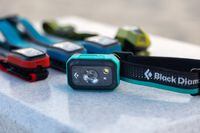The other day we talked about what to look for when trying to buy a decent headlamp, but we stopped short of actually recommending any products directly. But after our trip to the Outer Banks’ Portsmouth Island, we realized everyone on the trip was wearing a Black Diamond. That’s enough to constitute a ringing endorsement. Meet our family of Black Diamond headlamps.
Black Diamond Equipment got its start more than three decades ago, and since then has become a household name in outdoor circles. That experience filters down to its headlamps, which check all of the boxes on our list of must-have features. They are all compact, relatively affordable, feature single-press memory power buttons, and are rugged. The Black Diamond units are plastic to save weight (versus the aluminum Slonik from our buying guide), but it’s robust and can withstand all kinds of abuse.
One of the headlamps in the photo above has seen just days of use, and one of them is nearly a decade old, with the others falling somewhere in between. Our favorite comparison is the two blue units in the center. One of these Cosmo 300 models sees near daily use by a veterinarian. It has been covered in all manner of fluids, stepped on by people and animals alike, and usually just gets sloshed through a deep bucket of water at the end of the day to “clean it.” Despite the darkened color from the dirt, it looks and works exactly like the new one. The green one is almost 10 years old and works like new. We’ve seen Maglites that didn’t last that long.
Still, they’re not perfect, and there are few things to consider when looking at the Black Diamond headlamps. For starters, most of them are relatively low powered. The brightest light we have here is only 350 lumens. Most of Black Diamond’s headlamps are also non-rechargeable. Again, only one light out of the seven we brought on the Portsmouth trip can be recharged. These are far from deal breakers, but if you are the kind of person who might use your UTV for search and rescue activities or long excursions in open spaces like the desert, the lack of brightness and USB charging could make the difference for you.



/cloudfront-us-east-1.images.arcpublishing.com/octane/GQFAUVAEXJGH3EV2YFJVGBHSIM.jpg)
/cloudfront-us-east-1.images.arcpublishing.com/octane/WTGY4Y56LJC7RDF2T4YRI3YQSI.jpg)
/cloudfront-us-east-1.images.arcpublishing.com/octane/GS72673EPNDNJN3ZAF65HF6EFA.jpg)
/cloudfront-us-east-1.images.arcpublishing.com/octane/XBFWR7DIOJB5RMHBLDYA43OHV4.jpg)
/cloudfront-us-east-1.images.arcpublishing.com/octane/3NY5KEJHBBB7VFMJY2XCEIOKFU.jpg)
/cloudfront-us-east-1.images.arcpublishing.com/octane/YBV7QXPYBZFJLOCRLFBONY43XU.jpg)
/cloudfront-us-east-1.images.arcpublishing.com/octane/B7H7Z2RQY5ELXA2SNI3YQYUMGY.jpg)
/cloudfront-us-east-1.images.arcpublishing.com/octane/UINFGWI2IBEXNAOGNKWG7C55DA.jpg)
/cloudfront-us-east-1.images.arcpublishing.com/octane/KIGCDNPA2BBRPF2P2TNM7C7RFQ.jpg)
/cloudfront-us-east-1.images.arcpublishing.com/octane/PDEMU4PWE5CWPMZG2UN3WOYITE.jpg)
/cloudfront-us-east-1.images.arcpublishing.com/octane/4THQSV3RWVA3XJ3KNUPXHI247M.jpg)
/cloudfront-us-east-1.images.arcpublishing.com/octane/XKRWJYD6CRH27LYDXLOTUR6APA.jpg)
/cloudfront-us-east-1.images.arcpublishing.com/octane/OXHGSH5ZS5FI7G5QOSOCBG46FM.jpg)
/cloudfront-us-east-1.images.arcpublishing.com/octane/CBOXKHAPERCFVNPF2LDEJRBPBY.jpg)
/cloudfront-us-east-1.images.arcpublishing.com/octane/QSE6Q4OCZNAONDLCPKCWRDQHP4.jpg)
/cloudfront-us-east-1.images.arcpublishing.com/octane/MQ5DTNOGLVEPDNB3GC2WU6C5NA.jpg)